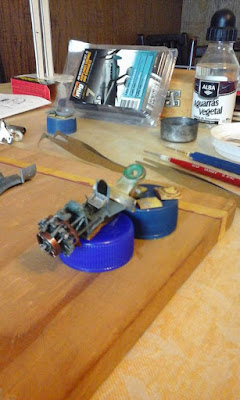The plane:
Through a lengthy process of incremental development, the Imperial Japanese Army Air Force came to adopt its first monoplane fighter in 1937 with the adoption of the Ki-27. Lightweight both structurally, in armament and specially in its handling, the aircraft met both enthusiasm and criticism from the Army pilots. As early as March 1938 in China, it was already noted that the pair of .303 machine guns was limited on its damaging power, who also used to remove the sliding canopy from its planes in order to improve visibility. Notwithstanding that, the aircraft was given great praise for its outstanding manouverability and fire accuracy.
Early combats also showed that lacking armour, it was very vulnerable to enemy fire. That was partially solved by improving pilot's training and by the time the first phase of the Nomonhan (Khalkhin Gol) Incident took place, japanese pilots were flying a mount which proved equal or superior to its soviet counterparts. Things started to go awry when the cannon armed I-16 Typ 17 reached IAPs and the russian tactics changed to a more energy-driven oriented kind of attack.
By the time WWII started, the basic design had been surpassed by more modern western designs but the aircraft soldiered on as a front line fighter for the first months of the Pacific War until replaced by the briefly more modern Ki-43 in 1942. The three last years of the war saw the Ki-27 serve as a trainer and later "special mission" suicide bomber. Today, only one survives at the Tachiarai Peace Memorial Museum, while a very nice "war weary" replica sits at the Tokorozawa Aviation Museum.
The Kit: ICM's Nakajima Ki-27a (#72201)
This kit is not new by any standards today, but it makes a welcomed replacement for the old and still noble Mania kit boxed by Hasegawa. It has an extremely fine interior with a complete cockpit and engine. ICM instructions are nice but the CAD type of illustration makes it hard sometimes to pinpoint the exact location of parts.
Fitting and more fitting is the keyword here. Still, you'll have to trim and shave to get a decent fit. Not that it's bad, but the kit comes from Eastern Europe and requires some TLC to get there. Oh, the surface detail is staggering.
Seat and engine were given their proper colours and the oil cooler ring painted in H-55 and H-11. Exhaust collectors were painted H-70 and then Mig Gimenez' Rust; all the work being sadly lost to the aerodinamic profile of the nose.
After mating all the main components and test fitting the propeller, it was time for painting. Canopy was glued via ClearCote and it provided a sturdy bond. H-144 was also used for it and the ailerons deflected as per photos of the original.
Humbrol's H-147 was used as base for the decals and it gives a nice rendition of the grey used by the IJAAF at the time.
The 59th Sentai machine was chosen since it gives a nice counterpoint between colours without being too showy. The decaling process is very straight forward but ICM decals can play havoc on your project and they did to some extent in this case. With extreme care and matching pieces of the same sheet the scheme was saved, but only so. I recommend to get new decals or have the utmost patience until ICM gets it right. Which it does from time to time, but it's kind of a russian roullette so better play it safe.
After the decaling process was over and Satin Cote applied, it was time for some weathering. I like to keep my models rather clean, so I went through archive photos on the Internet to get the feeling of a well used K-27 and most of the grime and tear seems to be focused on the engine and surrounding areas. Japanese engines were famous for being natural oil leakers, but their ground crews were also famous for keeping them spotless unless under heavy combat conditions.
Ammo's Aviation Oil and Exhaust set was used to replicate what was seen in period photos of Ki-27s at the Nomonhan Battle. A Silver Faber Castell pencil provided the slight chipping where necessary.
To end construction, both the propeller and gunsight were fitted to the airframe. All in all a most enjoyable build.
The Ki-27a was finished at the same time a Yak-9 Early Series, a much earlier release also by ICM and equally enjoyable in terms of modeling work.
The base is a simple square of MDF with its edges bevelled, painted matt white and then given some red lines with a Faber Castell pencil. It was weathered lightly for sake of congruence with the kit.
The final product, a Nakajima Ki-27a belonging to the 59th Sentai, 2nd Tutai, at the thick of the Nomonhan Plateau Battle in June, 1939. Bear in mind how lighting plays with colours depending on the use of flash or other conditions.
After some time, this little plane has grown to me with its ellegance, bearing whitness to the sheer ingenuity of its designers, who provided the IJAAF with what it needed; even if it was a concept so narrow in perspective that as superb as it seemed at the beginning, it spawned two pendular designs - the Ki-43 and the Ki-44 - going from un-armoured extreme manouverability to a plane that went like a rocket and hit like a boxer but didn't turn much. The ultimate fighter from Nakajima, the superb Ki-84, was yet sometime to appear on the horizon.
Until our next installment, take care and good luck.
The Modeling Underdog.







































Comments